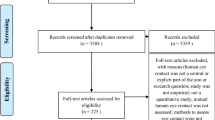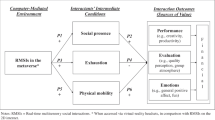Abstract
Like other communication media, a Collaborative Virtual Environment (CVE) enables interaction under certain characteristics. Here, the main display of nonverbal cues is through a graphical representation of the user in a computer-created environment; in such a way that nonverbal behavior in CVEs varies, not only because of the people and the scenario involved as in a face-to-face situation, but also because of technical and design issues. In order to present an overview of the nonverbal interaction conditions in this technology, the study of nonverbal interaction in face-to-face situations is here contextualized in CVEs.




Similar content being viewed by others
References
Breazeal C, Kidd CD, Thomaz AL, Hoffman G, Berlin M (2005) Effects of nonverbal communication on efficiency and robustness in human-robot teamwork. In: IEEE/RSJ international conference on intelligent robots and systems (IROS), pp 383–388
Gobron S, Ahn J, Garcia D, Silvestre Q, Thalmann D, Boulic R (2012) An event-based architecture to manage virtual human non-verbal communication in 3D chatting environment. Lect Notes Comput Sci 7378:58–68
Ellis S (1995) Origins and elements of virtual environments. Oxford University Press, New York
Schroeder R (2011) Being there together and the future of connected presence. Presence 15(4):438–454
Wolff R, Roberts D, Murgia A, Murray N, Rae J, Steptoe W, Steed A, Sharkey P (2008) Communicating eye gaze across a distance withoutrooting participants to the spot. In: Distributed simulation andreal-time applications, DS-RT 2008. 12th IEEE internationalsymposium. Vancouver, British Columbia, Canada
Spante M, Heldal I, Steed A, Axelsson A, Schroeder R (2003) Strangers and friends in networked immersive environments: virtual spaces for future living. In: Home oriented informatics and telematics (HOIT), Irvine, California, USA
Patterson ML (1982) A sequential functional model of nonverbal exchange. Psychol Rev 89:231–249
Patterson ML (1983) Nonverbal behavior. A functional perspective. Springer, New York
Knapp M, Hall J (2010) Nonverbal communication in human interaction, 7th edn. Thomson Wadsworth, Belmont
Steptoe W, Wolff R, Murgia A, Guimaraes E, Rae J, Sharkey P, et al. (2008) Eye-tracking for avatar eye-gaze and interactional analysis in immersive collaborative virtual environments. CSCW 2008 (ACM 2008 conference on computer supported cooperative work), San Diego, CA
Bailenson JN, Blascovich J, Beall AC, Loomis J (2003) Interpersonal distance in immersive virtual environments. Personal Soc Psychol 29:819–833
Schroeder R (2011) Being there together: social interaction in shared virtual environments. Oxford University Press, New York
Hall E (1968) Proxemics. Curr Anthropol 9:83–108
Greenwald HS, Knill DC, Saunders JA (2005) Integrating visual cues for motor control: a matter of time. Vis Res 45:1975–1898
Slater M (2009) Place illusion and plausibility can lead to realistic behaviour in immersive virtual environments. Philos Trans R Soc B: Biol Sci 364:3549–3557
Sanchez-Vives MV, Slater M (2005) From presence to consciousness through virtual reality. Nat Rev Neurosci 6:332–339
Robles-De-La-Torre G (2008) Principles of haptic perception in virtual environments. In: Grunwald M (ed) Human haptic perception. Birkhäuser, Boston, pp 363–379
Morris D, Tan H, Barbagli F, Chang T, Salisbury K (2007) Haptic feedback enhances force skill learning. In: Second joint eurohaptics conference and symposium on haptic interfaces for virtual environment and teleoperator systems, pp 21–26
Mine M, Brook FP, Sequin CH (1997) Moving objects in space: exploiting proprioception in virtual-environment interaction. Computer graphics proceedings, ACM SIGGRAPH 1997, pp 19–26
Hrimech H, Alem L, Merienne F (2011) How 3D interaction metaphors affect user experience in collaborative virtual environment. Adv Hum-Comput Interact. doi:10.1155/2011/172318
Gabbard J (1997) A taxonomy of usability characteristics in virtual environments. Dissertation, Virginia Polytechnic Institute and State University
Ahn SJ, Fox J, Bailenson JN (2012) Avatars. In: Bainbridge WS (ed) Leadership in science and technology: a reference handbook. SAGE, Thousand Oaks
Guye-Vuillème A, Capin TK, Pandzic IS, Thalmann NM, Thalmann D (1998) Nonverbal communication interface for collaborative virtual environments. In: Collaborative virtual environments. University of Manchester, Manchester, pp 105–112
Benford S, Greenhalgh C, Rodden T, Pycock J (2001) Collaborative virtual environments. Commun ACM 44:79–85
Capin TK, Pandzic IS, Thalmann NM, Thalmann D (1997) Realistic avatars and autonomous virtual humans in VLNET networked virtual environments. In: From desktop to webtop: virtual environments on the internet, WWW and networks, international conference, Bradford, UK
Lange B, Rizzo A, Chang CY, Suma EA, Bolas M (2011) Markerless full body tracking: depth-sensing technology within virtual environments. In: Interservice/industry training, simulation, and education conference (I/ITSEC), Las Vegas, NV, pp 1–8
Jovanov E, Hanish N, Courson V, Stidham J, Stinson H, Webb C, Denny K (2009) Avatar–a multi-sensory system for real time body position monitoring. In: Engineering in medicine and biology society, EMBC 2009. Annual international conference of the IEEE, pp 2462–2465
Mehrabian A (1976) Public places and private spaces: the psychology of work, play, and living environments. Basic Books, New York
Becker B, Mark G (2002) Social conventions in computermediated communication: a comparison of three online shared virtual environments. In: Schroeder R (ed) The social life of avatars: presence and interaction in shared virtual environments. Springer, London, pp 19–39
Salem B, Earle N (2000) Designing a non-verbal language for expressive avatars. In: Collaborative virtual environments, San Francisco, CA, pp 93–101
Clark HH, Brennan SE (1991) Grounding in communication. In: Resnick LB, Levine JM, Teasley SD (eds) Perspectives on socially shared cognitionHyattsville. American Psychological Association, MD, pp 127–149
Vinayagamoorthy V, Gillies M, Steed A, Tanguy E, Pan X, Loscos C, Slater M (2006) Building expression into virtual characters. In: Eurographics conference state of the art reports, Vienna, Austria
Fabri M (2006) Emotionally expressive avatars for collaborative virtual environments. Dissertation, Leeds Metropolitan University
Ekman P (1973) Darwin and facial expression; a century of research in review. Academic Press, New York
Ekman P (1978) Facial expression. Erlbaum, Hillsdale
Wolff R, Roberts D, Murgia A, Murray N, Rae J, Steptoe W, Steed A, Sharkey P (2008) Communicating eye gaze across a distance withoutrooting participants to the spot. In: Distributed simulation andreal-time applications, DS-RT 2008. 12th IEEE internationalsymposium. Vancouver, British Columbia, Canada
Peña A (2009) A model for 3D virtual environment for learning based on the detection of collaboration through an autonomous virtual tutor. Dessertation, Universidad Politécnica de Madrid
Peña A, de Antonio A, (2007) A model to detect collaborative interaction in 3D CVEs for learning through non verbal communication. In: IX SIIE’07, Instituto Politécnico do Porto, Porto
Juslin PN, Scherer KR, Harrigan J, Rosenthal R (2005) Vocal expression of affect. In: Harrigan J, Rosenthal R, Scherer KR (eds) The new handbook of methods in nonverbal behavior research oxford. Oxford University Press, UK, pp 65–135
Choueiri EY (2010) Optimal crosstalk cancellation for binaural audio with two loudspeakers. http://www.princeton.edu/3D3A/Publications/BACCHPaperV4d.pdf. Accessed January 2013
Walther JB, D’Addario KP (2001) The impacts of emoticons on message interpretation in computer-mediated communication. Soc Sci Comput Rev 19:324–347
Walther JB (2006) Nonverbal dynamics in computer-mediated communication, or : (and the net : (‘s with you, :) and you :) alone. In: Manusov V, Patterson ML (eds) Handbook of nonverbal Communication. Sage, Thousand Oaks, pp 461–479
Steed A, Roberts D, Schroeder R, Heldal I (2005) Interaction between users of immersion projection technology systems. In: 11th international conference on human computer interaction, Las Vegas, NV
Peña A, de Antonio A (2010) Inferring interaction to support collaborative learning in 3D virtual environments through the user’s avatar nonverbal communication. IJTEL 2:75–90
Author information
Authors and Affiliations
Corresponding author
Rights and permissions
About this article
Cite this article
Peña Pérez Negrón, A., Rangel Bernal, N.E. & Lara López, G. Nonverbal interaction contextualized in collaborative virtual environments. J Multimodal User Interfaces 9, 253–260 (2015). https://doi.org/10.1007/s12193-015-0193-4
Received:
Accepted:
Published:
Issue Date:
DOI: https://doi.org/10.1007/s12193-015-0193-4




